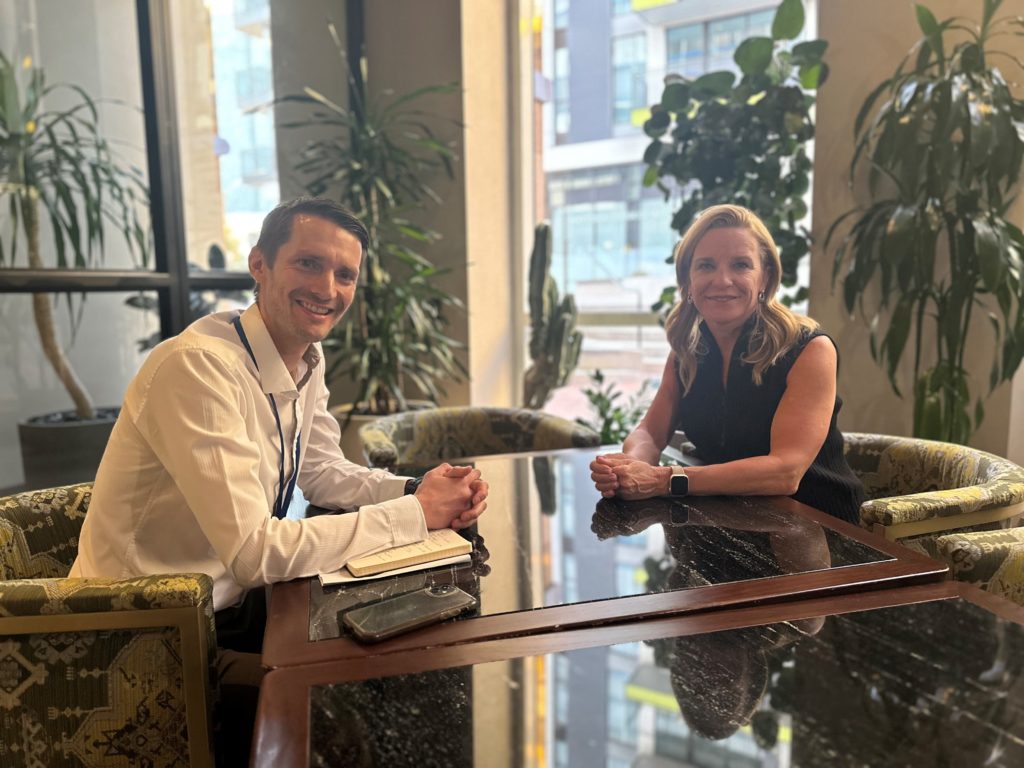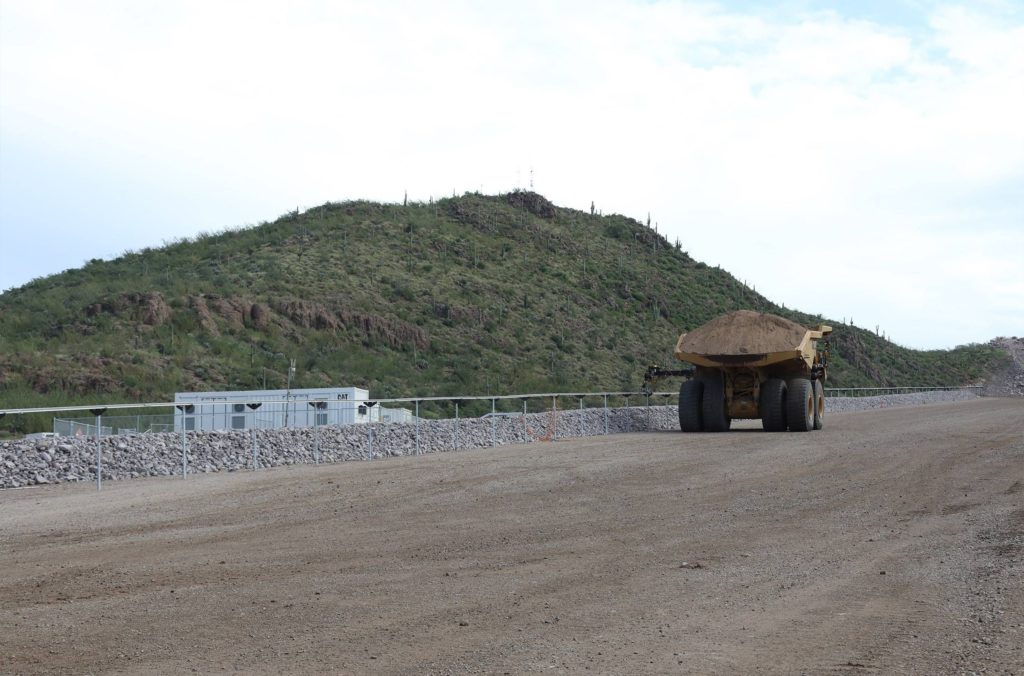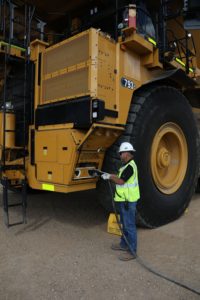In the leadup to this week’s MINExpo 2024, Caterpillar has been making headlines across the mining technology space with a string of announcements related to mine site electrification. IM got a chance to sit down with Caterpillar Resource Industries Group President, Denise Johnson, to talk through these and more.
The following Q&A picks up from a discussion Editorial Director, Paul Moore, had with Johnson and Brian Weller, Vice President of Electrification, in the leadup to MINExpo 2021, in Las Vegas.
IM: When comparing where the industry is now with the electrification trends and indicators seen just before MINExpo 2021, what do you view as the major energy sources for ultra-class haul trucks to allow miners to achieve some of their net-zero, scope one emission targets? Has your viewpoint changed over that three-year period?
DJ: I don’t think it has changed. Three years ago, we had a vision of the predominant choice for zero exhaust emission haul trucks being battery-electric. Three years later, that vision has been maintained.
You could argue that the battery chemistry has evolved over that time frame, but the expected solution set has broadly remained the same. If anything, we have been able to further validate battery-electric trucks as the optimal choice over that three-year period.
What has changed though is the approach to this from mining companies. There is much more of an interest in ‘stepping into’ the electrification journey, versus just ‘flipping a switch’. In other words, we’re seeing more customers being interested in transitioning over time, which is one of the reasons why we have accelerated the development of our Dynamic Energy Transfer (DET) solution, which can already be leveraged with diesel-electric (AC) trucks. This allows customers to start to transition their site infrastructure now, without having to progress all the way to where they need to from an electrification perspective. It allows them to hit their interim greenhouse gas (GHG) reduction targets at the same time, ahead of those longer-term net zero ones.
I think that strategy is very appealing to many customers as they start to look at how to implement electrification effectively over time.
IM: Does this approach differ from region to region (as well as site to site) based on, for example, diesel price benchmarking, access to renewables, energy infrastructure, etc?
DJ: Absolutely. There are some places in the world where sourcing renewable energy is very easy – whether that is through hydropower, solar, wind, etc – and there are others where it is much more challenging. So, we still see that spread with our customers; everywhere from wanting to continue with traditional equipment, all the way to going fully electric.
I would say Australia is probably leading the movement towards electrifying and going all out to achieve zero GHG emissions. A lot of that is driven by carbon tax, government incentives and other aides.

IM: Of the solutions out there, do you see diesel-electric, progressing to battery-electric integrated with stationary charging and DET as the most viable commercialisation route?
DJ: I think mining companies are interested in exploring all the solution sets. From an economic perspective, there is still a lot to figure out in terms of how those will be commercialised.
While I don’t think the commitment towards electrifying has changed, the timeline around when they want to introduce electrification remains the biggest question mark. That is something we are working on, especially with our Early Learner customers. We want them to give us feedback on what timeline they would like to move forward with commercialising. We, in turn, want to make sure we’re meeting what our customers dates are.
IM: Within this electric haulage evolution, is there also a case to be made for exploring a ‘hybrid’ electric solution including battery pack, energy storage component and a smaller on-board engine?
DJ: We’ve studied that heavily and it depends on the mine site as to whether it would be an effective and economically viable option. We have done a lot of simulations around what would be required and, for some mines – especially deep pit mines – the amount of energy you need to pull the truck out of the pit would require the same size engine as you have on a diesel-electric truck today. A smaller engine, combined with an acceptably sized battery and an energy storage source, would not allow you to achieve that same haulage route.
There are other applications that could technically work, but the economics do not make sense now.
We really look at the DET with the diesel engine as our ‘hybrid’ solution. As you see today, we’re basically taking the engine down to idle when it is being propelled on the DET line. The ability to do that allows you to hit that hybrid ‘sweet spot’.

IM: And DET could also, in theory, allow you to use a smaller battery on board these trucks in certain applications…
DJ: Yes, which allows you more payload potential in those applications as well.
IM: I read that you have now built and tested seven Early Learner 793 XEs to date. What stages are these at in terms of getting to site for testing? Am I right in thinking the one at Newmont’s Cripple Creek & Victor has now been assembled?
DJ: Yes, that one [the Early Learner 793 XE at Cripple Creek & Victor] is going to start running soon. Another one has just arrived in Western Australia too; they are in the midst of transporting that to the test site.
IM: In terms of those Early Learner mine sites, how selective have you been able to be with the applications chosen to give you a wide breadth of knowledge as to how these battery-electric trucks may perform across different types of mine sites?
DJ: We, with our customers, have intentionally chosen the Early Learner site locations to hit ‘corner cases’ for battery truck validation: we have deep pit, we have high altitude, we have cold temperature, we have hot temperature, etc. We are really trying to ensure we hit all those corner cases so the validation that we are doing of not only the technology, but also the application, allows us to understand and learn. We have full confidence that iterations will be required, and we want to do that as soon as possible, so that is why we are sending these machines to the broad corner cases we are.
The customers are also looking for reassurance, as well. One of the things we are doing with the Caterpillar Early Learners is sending engineers to the site to help with that learning cycle. Our team will be right there at the mine site watching, first hand, the development and evolution of the technology as it iterates.
IM: Is that information – in terms of application performance – going to be shared across the Early Learner partner framework as well?
DJ: So, both our Early Learner customers and our Pathway to Sustainability customers are going to be learning with us and finding out what we are seeing at these sites. It is intended to be an industry learning opportunity. There are certain details that cannot be shared, but, when it comes to things like change management for people, and certain processes, technology and infrastructure, we will be sharing that information. It is important to spread this across the industry, and that is the intention of these specific programs.
IM: Might some of these Early Learners and Pathway to Sustainability customers also use DET within this process? Is that part of the conversation?
DJ: In some of these applications, yes, DET will be part of the solution. We will be carrying out field-follow trials on DET in 2025, intending to go into production with it in 2026, so that aligns well with our Early Learner trials.
IM: When it comes to batteries, has your thinking around the supply chain and creating the volumes needed to rapidly bring down the cost changed over this time period (2021 vs 2024)? Could you, for instance, look to acquire more off-the-shelf battery packs/modules, instead of creating customised battery solutions, to lower the cost of the overall battery truck?
DJ: No, our thinking hasn’t changed. We have a number of development agreements with various companies around battery technology that we’re continuing to build on. We think deep integration in this supply chain is important. We won’t be manufacturing cells; we will procure those from a variety of sources around the world, not just one source. The intention would be for us to take the battery cells, make the battery packs and racks, integrate that into our software, the cooling and all the controls. We think it will be a competitive advantage for us, and benefit our customers best, if we do it ourselves. That control system will allow deeper integration into the machine platform and the energy management component. We think it is a core part of what will make our product the optimal solution for our customers.

IM: Does that also come with an extra cost element?
DJ: It could. Caterpillar could buy battery packs off the shelf, but then, what would be the difference between Cat’s solution and anyone else’s? If we think Caterpillar’s control system – through cooling and battery management, for instance – will allow batteries to last longer, then that will allow our customers to achieve the lowest total cost of ownership (TCO). This is important as the battery represents a substantial cost, especially with the scale of the machines we are talking about. We need to be mindful of trying to make them last longer, while servicing and repairing them in an optimal manner.
The lifecycle of the battery is important to achieving this low TCO – from procurement of the cell through to secondary use, which we can leverage oftentimes in a stationary energy storage system application, through the recycle process. We may not do every piece of this – the recycling piece, for instance – but we want to be able to operate that complete lifecycle ecosystem in the way that makes the most sense and provides the best customer value.
IM: How advanced are you in terms of simulation, design and fleet management integration for the deployment of battery trucks? How important will this element be for customers achieving the results they want?
DJ: We have developed a completely in-house simulation software for this, which I am really excited about. The simulation tools will help us in ways we would never have imagined before, and it will be integrated into our autonomy solution as well. This will allow it to be used for advanced planning of the mine site itself, but also for decision support as to when to, for example, move the DET around the site, select how many trucks will be needed around the site, and how to optimise productivity within those confines.
We have already learned a lot from the Early Learner customer sites as a starting point for simulations, visualising their mine sites to help inform them of what they might need from a site infrastructure and energy management perspective. This is where we’re pulling in our energy & transportation expertise to help such analysis, as well as our digital team. It is an enterprise-wide focus that allows us to pull in a lot of skillsets from the entire team.
IM: Could such a solution be rolled out to customers as well?
DJ: We think it will be a very important tool for our customers. We think it will drive down the cost and ensure site optimisation is done at a much broader level than it is today.
IM: Lastly, you mentioned to Paul three years ago that you did see cabless trucks coming in the future. How far away from this future are we now?
DJ: It will depend on our customers pull for it; right now, we’re still putting cabs on trucks! Customers still want that versatility.
But there is a huge advantage to taking the cab out of the equation – in terms of weight and cost. It also allows much greater freedom in design iteration. Additionally, payload increases could be reaped.
We have some cabless designs out there already, but we are waiting for the customer pull. It is the customers that will ultimately help us decide when they are ready for those.
IM: I guess you could give the ultimatum of, ‘You can have a cab on the truck, but you’ll have to forego, say, 500 kW of additional battery capacity to have that cab.’ That may also focus their minds…
DJ: That sort of trade-off may be an option for our customers to consider. I also think as autonomy adoption continues to increase; it will help facilitate the likelihood of that taking place. There will have to be a way to remotely recover those units, but we already do that today.



